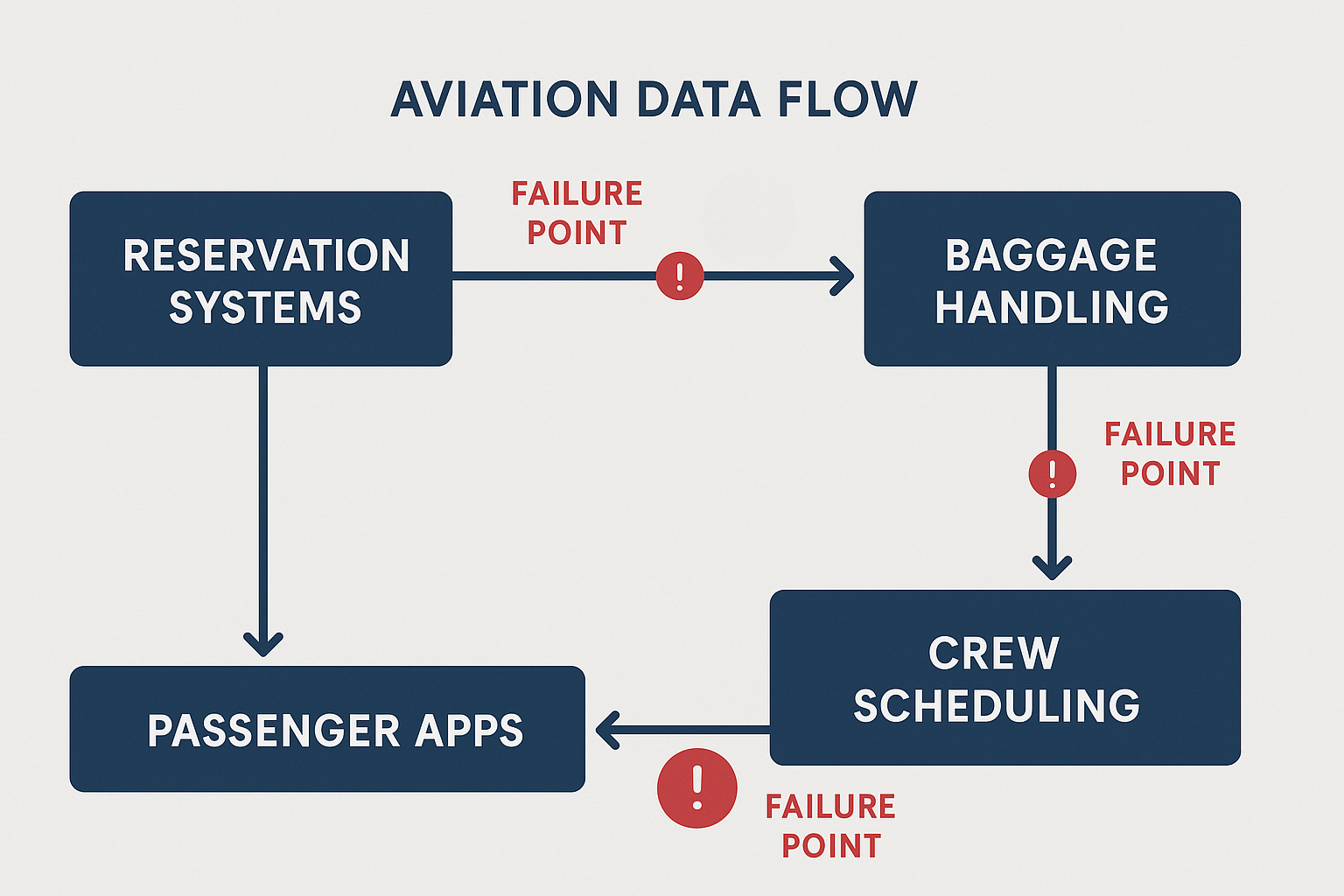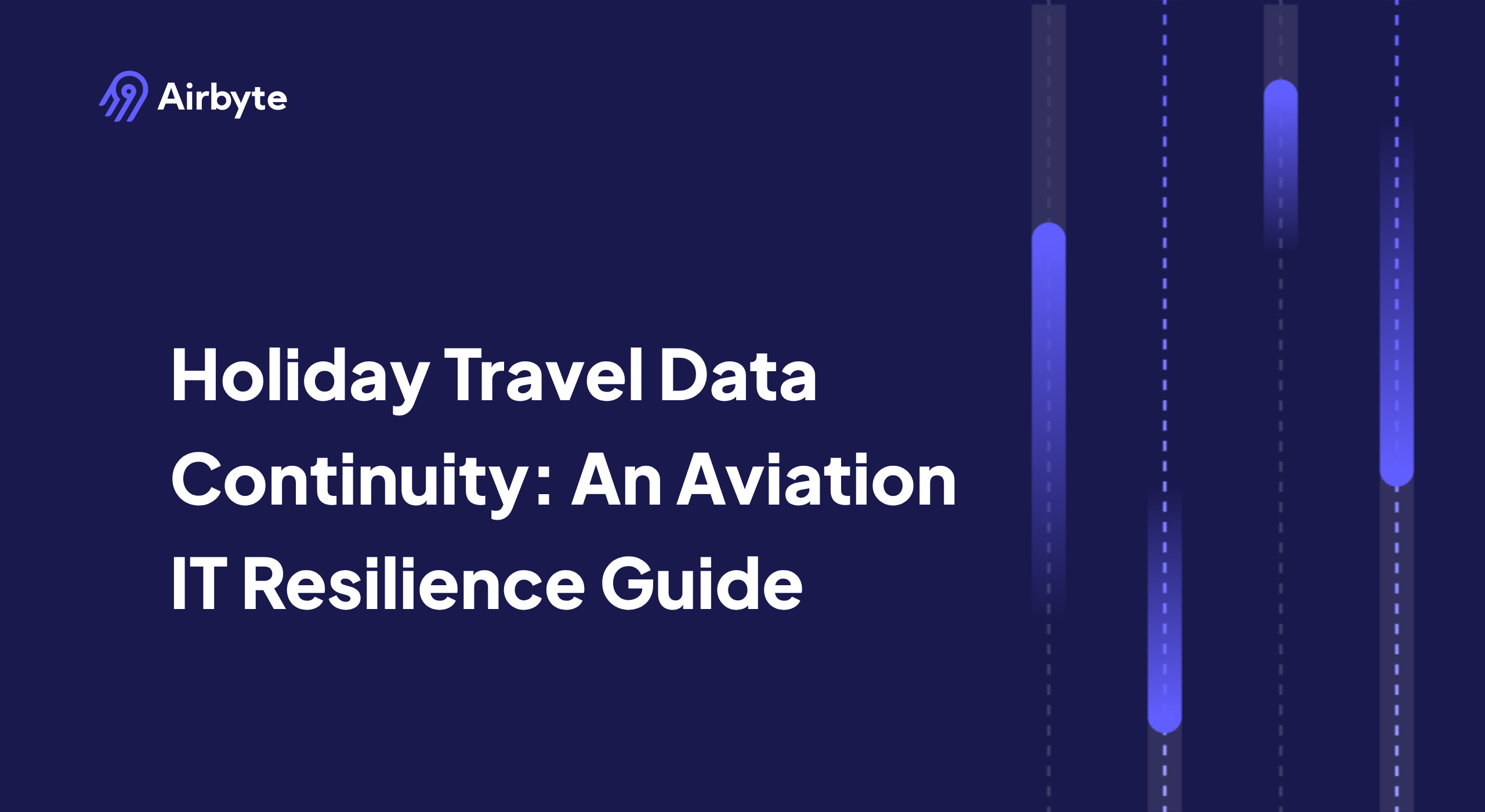Holiday Travel Data Continuity: An Aviation IT Resilience Guide
Summarize this article with:
✨ AI Generated Summary
Check-in kiosks freeze during Thanksgiving weekend. Mobile apps crash when passengers need them most. Baggage scanners go offline just as lines stretch around terminals. When a booking database stalls for even a few minutes, flights cascade into delays, manifests disappear, and ground crews work in the dark without updated schedules.
Holiday travel data continuity means your IT stack keeps information accessible, synchronized, and trustworthy across cloud and on-premises environments, even when systems hit breaking points. This requires redundant pipelines, near-real-time change data capture (CDC) replication, and hybrid architectures built to absorb traffic surges without bringing operations to a halt.
What Causes Data Disruptions During Peak Travel Seasons?
Holiday traffic transforms normal friction points in your aviation IT stack into serious operational challenges. When summer or year-end demand pushes systems close to maximum capacity, even a few seconds of lag on reservations or baggage feeds can ripple through the entire network of carriers and ground handlers.
Common disruption patterns include:
- Legacy on-premises databases without replication create single points of failure that can't absorb holiday traffic spikes
- Siloed sources scattered across airports prevent unified visibility when you need it most
- Integration hubs straining under record booking volumes stall the flows you rely on for operations
- Power failures at primary facilities can wipe out scheduling, check-in, and crew systems worldwide
- Cloud misconfigurations or region-wide outages threaten operations if multi-region failover hasn't been tested
- Post-pandemic staff shortages mean fewer engineers on call to diagnose slow queries or re-queue failed CDC jobs
- Newer hires facing unfamiliar legacy interfaces drag out recovery times during critical incidents
- Weather-driven reroutes force mass updates across flight plans, crew rosters, and passenger manifests
If information synchronization lags behind rapid changes, confusion spreads quickly through your operations and passenger-facing systems.

How Can Aviation IT Teams Architect for Holiday Data Continuity?
Holiday surges expose every weak spot in your stack. When infrastructure fails, you need near-real-time replication, resilient messaging, smart segmentation, and automated recovery working in concert.
1. Adopt a Hybrid, Multi-Region Data Architecture
Distributing workloads across on-premises racks and several clouds provides the foundation for resilient operations. A hybrid control plane steers traffic while local processing planes keep personal information inside their jurisdiction. Geo-redundant replication between AWS us-east and eu-central means booking updates survive a regional outage and remain close to passengers, reducing latency because compute runs in the same region as the request.
2. Implement Continuous Data Replication Pipelines
Change data capture pipelines stream inserts and updates with low latency. Running synchronous mode for passenger manifests and asynchronous multi-site mode for telemetry balances cost and consistency. If the primary database goes dark, fresh transactions appear instantly on the secondary so check-in agents never notice the failure.
3. Build Resilient API and Messaging Layers
Message queues like Kafka or Amazon SQS handle traffic spikes by buffering millions of events per second, keeping downstream APIs responsive. Wrapping each call with retries, rate limits, and circuit breakers ensures a failed weather feed doesn't freeze your entire check-in stack.
4. Segment Critical vs. Non-Critical Systems
During an outage, crew scheduling matters more than loyalty-program analytics. Classifying information flows allows you to reserve your fastest links and most durable storage for core flight, passenger, and crew records while batch marketing or BI jobs wait. This placement strategy also eases residency rules: sensitive PII stays local while aggregates move to the cloud.
5. Automate Failover and Disaster Recovery Testing
Scripting failover to complete faster than a customer can tweet requires health checks watching every region. When one fails, traffic shifts automatically and replicas promote themselves. Regular drills verify recovery time meets business requirements.
How to Maintain Visibility During Holiday Demand Spikes
When aircraft push maximum block hours and gates turn over in minutes, you can't afford to discover problems after passengers are already queuing. Continuous, end-to-end observability lets you spot replication lag, message-queue backlogs, or API timeouts before they freeze operations.
Effective monitoring requires disciplined practices that keep the signal-to-noise ratio high:
- Centralize dashboards across every critical system (bookings, crew, maintenance, baggage) to get one pane of glass rather than twenty browser tabs
- Aggregate logs and metrics into a data lake using tools like ELK, Datadog, or Splunk to remove blind spots created by regional information silos
- Run anomaly detection on traffic patterns and replication lag to surface hidden issues before they impact passengers
- Set alert thresholds for queue depth, API latency, and CDC offset to ensure the right people are paged before passengers feel the impact
- Stream both CDC offsets and gate-side API latency into the same dashboard so you can see backlogs building and scale consumers or reroute traffic while flights remain on schedule
- Automate quality checks, including type validation, schema drift detection, and reconciliation against a single source of truth, to catch silent corruption that dashboards can't
- Publish dashboards to operations leaders and open shared channels for on-call engineers to ensure everyone sees the same near-real-time picture
- Conduct quick post-mortems after each spike to feed fixes back into your monitoring strategy
Visibility only works when the information you monitor is trustworthy. Keeping communication lines as integrated as your telemetry helps fixes happen before disruptions cascade.
How Can Aviation Teams Integrate Security and Compliance Into Continuity Planning?
Security lapses during a holiday rush can wipe out the very resilience you spent months building. Every continuity measure (failover clusters, replicated pipelines, hybrid processing planes) needs controls that satisfy PCI DSS for card information and GDPR for passenger privacy if they process or store such data.
1. Map Where Sensitive Data Travels Across Your Infrastructure
Start by mapping where personal and payment information travels across booking engines, airport kiosks, and cloud replicas. A thorough inventory lets you apply security controls from the first byte, then prove compliance during audits. Segmenting networks so critical systems like payment gateways and passenger manifests sit in isolated zones prevents cascading failures.
2. Encrypt Data in Transit and at Rest
Encrypting information in transit using TLS 1.2+ and at rest with AES-256 is necessary, but not by itself sufficient, to meet PCI DSS 3 and GDPR Article 32 requirements. Comprehensive compliance also requires robust key management, access controls, logging, and organizational safeguards.
Configuring IAM roles with least-privilege access ensures that only approved services can access replicated datasets, preventing unauthorized access during failover scenarios. Applying outbound-only network rules for synchronization jobs limits attack vectors while maintaining the flow necessary for continuity operations.
3. Maintain Immutable Audit Logs Throughout Replication Infrastructure
Continuous replication becomes useless if you can't demonstrate information integrity during an investigation. Maintaining immutable audit logs throughout your replication infrastructure proves essential for compliance and incident response.
4. Run Security Regression Tests Before Peak Seasons
Running security regression tests before peak seasons surfaces misconfigurations while you still have breathing room. Conducting thorough vendor due diligence on third-party APIs that power loyalty redemptions or weather feeds ensures these systems uphold the same controls as your internal infrastructure.
By folding these controls into your continuity plan, you can fail over confidently, knowing replicated information remains both available and compliant even when holiday traffic pushes every system to its limits.
What Role Does Unified Integration Architecture Play in Data Continuity?
Holiday traffic spikes reveal integration bottlenecks between reservation systems, baggage scanners, and weather feeds. A unified integration architecture connects these sources through a central control plane, moving information once and making it available everywhere you need it. When you orchestrate pipelines centrally while running them close to each airport, you eliminate latency and prevent the cascade of mismatched records that follows an outage.

Airbyte Enterprise Flex demonstrates this approach effectively. Its hybrid control plane handles orchestration in the cloud while an outbound-only processing plane runs inside your network. Sensitive passenger or payment information never leaves the region, yet you still use the same 600+ connectors and monitoring tools. Because each location executes version-controlled jobs, you eliminate environment drift, reduce maintenance overhead, and gain the confidence to fail over traffic without rewriting pipelines.
How to Prepare for the Next Holiday Surge (Action Plan)
Spikes in passenger volume follow the same calendar every year, so your playbook should already be written and tested before the first boarding pass is printed. Use this focused cycle to harden continuity ahead of the rush:
- Audit pipelines for single points of failure by tracing every booking, baggage, and crew-schedule flow end-to-end and flagging components that lack redundancy
- Deploy cross-region CDC replication using continuous replication across geographically separated instances to keep information current even if a region disappears overnight
- Stand up up-to-date observability dashboards that aggregate logs and replication metrics, triggering alerts when lag, queue length, or API latency drifts from normal
- Automate failover drills to rehearse regional cutovers until recovery time consistently sits under 15 minutes
- Run post-incident reviews through formal lessons-learned sessions that feed fixes back into architecture and playbooks
- Schedule these steps quarterly in sync with peak-travel calendars, and document every finding
Iteration keeps your systems ready for the next holiday surge.
How to Keep Every Flight, Passenger, and Data Stream Moving?
Holiday travel continuity depends on unified, redundant pipelines across hybrid architectures. Airbyte Enterprise Flex delivers this through a hybrid control plane that orchestrates from the cloud while processing planes run inside your infrastructure, keeping sensitive data in your VPC or data center. With 600+ connectors and version-controlled jobs, you can fail over between regions without rewriting integrations.
Talk to Sales about architecting aviation data continuity with hybrid deployment and data sovereignty controls.
Frequently Asked Questions
What is the typical recovery time objective for aviation data systems during holiday travel?
Recovery time objectives vary by system criticality. Passenger manifests and crew scheduling require sub-five-minute recovery, while baggage tracking needs under 15 minutes to prevent cascading delays. Analytics systems can tolerate 30-60 minute windows. Test your actual recovery time through quarterly drills to avoid surprises during holiday peaks.
How do hybrid architectures help with aviation data compliance requirements?
Hybrid architectures separate the control plane (orchestration in the cloud) from the data plane (processing in your infrastructure). Sensitive passenger and payment data never leave your VPC or data center, satisfying GDPR and PCI DSS requirements. You get cloud benefits like centralized monitoring while maintaining complete data sovereignty.
What replication latency should aviation teams target for operational systems?
Operational systems like check-in, baggage tracking, and crew scheduling need sub-minute replication latency for faster decision-making. Gate assignments can tolerate 1-3 minute lag. Financial reporting works fine with 5-15 minute delays. Monitor your specific requirements and tune accordingly.
How many geo-redundant regions should aviation companies deploy for data continuity?
Most aviation operations need at least two regions: one primary and one secondary. Global carriers often deploy three or more to reduce latency for international operations. Place regions close to major hubs (headquarters, largest airports, reservation centers) to minimize network latency. Avoid single-region deployments for mission-critical systems.

.webp)
